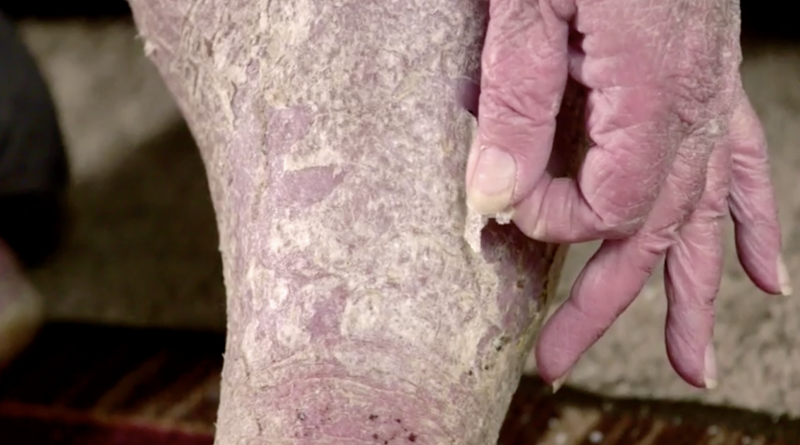- The latest episode of “Dr. Pimple Popper,” the TLC series starring dermatologist Sandra Lee, featured a man named Louis struggling with scaly, painful skin.
- Lee diagnosed Louis with a type of ichthyosis, a group of conditions that cause skin to thicken and form scales.
- She prescribed Louis a “wet wrap” skin-care technique that resulted in major improvement.
- Warning: This post contains graphic images.
The second season of “Dr. Pimple Popper,” the TLC series starring dermatologist Sandra Lee, is well underway, and so far, it’s continued to showcase a variety of jaw-dropping pops and fascinating skin issues.
The episode, which aired Thursday night, centered around one man’s painful, scaly skin condition – and his dramatic, tear-jerking transformation after just a few weeks of treatment.
Here’s a closer look at his story.
Louis developed a mysterious, scaly skin condition as an adult

In an interview segment, Louis, 70, said he was seeking Lee's help for an undiagnosed skin condition. On camera, he displayed patches of thick, scaly, almost eerily white skin covering his feet and legs. The scaliness appeared on his face and arms, too.
"On a scale of one to 10, the pain on my feet is nine or 10," he said. "It impairs me from being able to do just normal things."

Louis, a veteran of the Navy and the Army National Guard, added that his symptoms surfaced shortly after he served in Kuwait during Operation Desert Storm.
"After I came back home, my skin started curling up on me. I started getting these heavy duty gashes down my feet. And this skin condition kept getting worse and worse," he said. "I just want to know exactly what I got."
Lee biopsied his skin and prescribed a "wet wrap" regimen
After an initial exam, Lee said that Louis had "the most extreme case" of scaly skin that she'd ever encountered.
"This is way beyond athlete's foot or regular dry skin," she said. "I mean this is scale upon scale upon scale. Sure, I've seen things like this in textbooks, but I've never seen it in person."
In order to diagnose Louis, Lee performed what's called a punch biopsy.

"Usually, if you want to detect inflammatory skin conditions, we take a punch of skin," she said. "That's not just taking the surface of the skin - you're taking deeper structures, you want to get to the level of fat. It's very much like taking a straw and taking a core out of a cake. You can pull it out and see all the layers of the cake."
Then, Lee instructed Louis and his son, Jacob, on a new skin-care routine they could employ while waiting for the biopsy results.
It's a technique Lee called "wet wrapping." She described it as a way to "to put moisture back and keep it there in the skin."

There are several different protocols for wet wrap therapy, according to a 2015 review on the subject, but the general idea is to apply moisturizer or topical treatments, then wrap the skin in a layer of wet bandages and a layer of dry bandages. The technique has been used to treat eczema as well as other itch-causing conditions, according to a 2009 paper published in the Journal of the American Academy of Dermatology.
Lee slathered Louis' foot and ankle with Vaseline, then covered the area with a wet, sock-like fabric tube. Next, she wrapped the area with a layer of plastic wrap and a cloth bandage.
Tests revealed that Louis has an 'ichthyosis condition'
Five weeks after the initial visit, Louis and his son returned to Lee's office. Lee delivered the results of the biopsy, saying it was identified as an ichthyosis condition.
Ichthyosis is a catchall name for a group of more than 20 different conditions that cause dry, scaly, thick skin, according to the American Academy of Dermatology (AAD).

Some types of ichthyosis are inherited, with symptoms appearing at birth or during a baby's first year of life, while acquired ichthyosis appears during adulthood, according to England's National Health Service (NHS). Acquired ichthyosis is typically linked to another existing condition (like underactive thyroid, kidney disease, or Hodgkin lymphoma, a type of cancer) or may be triggered by some medications.
To address dryness and scaliness of ichthyosis conditions, dermatologists prescribe or recommend moisturizing and exfoliating products and routines, the NHS adds.
In the episode, it was not made clear exactly what type of ichthyosis Louis was diagnosed with, or whether it was associated with any other medical conditions, although Lee did describe it as "acquired" because it began when he was an adult. Lee told Louis that it was hard to pinpoint the reason he developed the disease, but added that, because it was acquired, it was unlikely he has passed it down to his son.
After five weeks, his skin improved and his pain levels dropped
Lee then examined Louis' skin for signs of improvement after several weeks following the wet wrapping regimen. She noted that his face and arms were less flaky. But the episode's biggest reveal came when Lee removed Louis' sock to see the skin of his feet.
The improvement was dramatic: Louis' once thick, white, and flaky skin appeared noticeably smoother and pink. Lee said it looked "spectacular."

"I don't think I've seen his feet pink in over a decade," Jacob, Louis' son, told Lee.
Perhaps even more importantly, Louis said his pain had diminished, too.
"I walk without my cane now, I have no pain," Louis said to Lee, through tears. "I've just been walking like crazy...and I'm even looking forward to dancing again." (In fact, as the episode's credits rolled, Louis and Lee did share a brief dance session right in the exam room.)

"I really felt that when I first met [Louis], he sort of had given up and he didn't really know what to do," Lee said at the episode's conclusion. "And I kind of suspected that maybe if I gave him something really concrete to do, that it would help improve things. But it really was all up to him."
Catch a sneak peek of Louis' story in the video clip below. You can also watch all episodes of "Dr. Pimple Popper" on TLC's website or the TLC Go app (available for Apple and Android).
Visit INSIDER's homepage for more.
